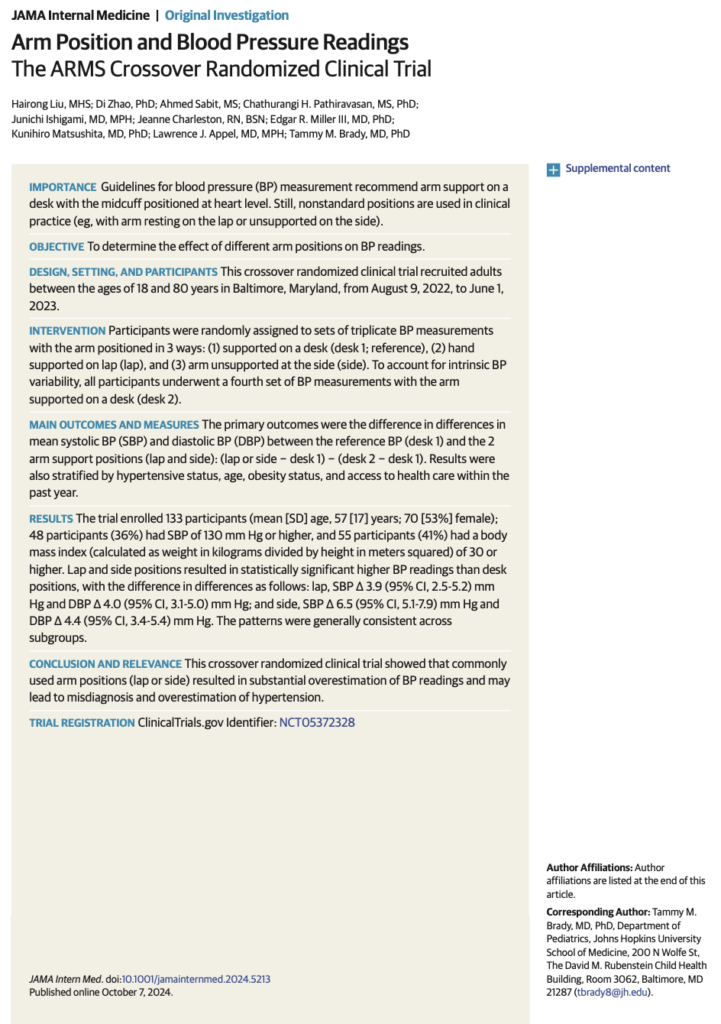Faulty blood pressure readings can put lives at risk. A new randomized clinical trial shows that commonly used arm positions (lap or side) result in substantially higher blood pressure readings which can lead to false diagnoses and over-treatment. To measure blood pressures accurately, the arm should be supported at heart level. The authors call for clinical guidelines to include this new evidence-based knowledge.
Question What is the effect of commonly used arm positions on blood pressure (BP) measurements compared to the standard, recommended position?
Findings This crossover randomized clinical trial of 133 adults showed that supporting the arm on the lap overestimated systolic BP by 3.9 mm Hg and diastolic BP by 4.0 mm Hg. An unsupported arm at the side overestimated systolic BP by 6.5 mm Hg and diastolic BP by 4.4 mm Hg, with consistent results across subgroups.
Meaning Commonly used, nonstandard arm positions during BP measurements substantially overestimate BP, highlighting the need for standardized positioning.
Importance Guidelines for blood pressure (BP) measurement recommend arm support on a desk with the midcuff positioned at heart level. Still, nonstandard positions are used in clinical practice (eg, with arm resting on the lap or unsupported on the side).
Objective To determine the effect of different arm positions on BP readings.
Design, Setting, and Participants This crossover randomized clinical trial recruited adults between the ages of 18 and 80 years in Baltimore, Maryland, from August 9, 2022, to June 1, 2023.
Intervention Participants were randomly assigned to sets of triplicate BP measurements with the arm positioned in 3 ways: (1) supported on a desk (desk 1; reference), (2) hand supported on lap (lap), and (3) arm unsupported at the side (side). To account for intrinsic BP variability, all participants underwent a fourth set of BP measurements with the arm supported on a desk (desk 2).
Main Outcomes and Measures The primary outcomes were the difference in differences in mean systolic BP (SBP) and diastolic BP (DBP) between the reference BP (desk 1) and the 2 arm support positions (lap and side): (lap or side − desk 1) − (desk 2 − desk 1). Results were also stratified by hypertensive status, age, obesity status, and access to health care within the past year.
Results The trial enrolled 133 participants (mean [SD] age, 57 [17] years; 70 [53%] female); 48 participants (36%) had SBP of 130 mm Hg or higher, and 55 participants (41%) had a body mass index (calculated as weight in kilograms divided by height in meters squared) of 30 or higher. Lap and side positions resulted in statistically significant higher BP readings than desk positions, with the difference in differences as follows: lap, SBP Δ 3.9 (95% CI, 2.5-5.2) mm Hg and DBP Δ 4.0 (95% CI, 3.1-5.0) mm Hg; and side, SBP Δ 6.5 (95% CI, 5.1-7.9) mm Hg and DBP Δ 4.4 (95% CI, 3.4-5.4) mm Hg. The patterns were generally consistent across subgroups.
Conclusion and Relevance This crossover randomized clinical trial showed that commonly used arm positions (lap or side) resulted in substantial overestimation of BP readings and may lead to misdiagnosis and overestimation of hypertension.
Trial Registration ClinicalTrials.gov Identifier: NCT05372328



